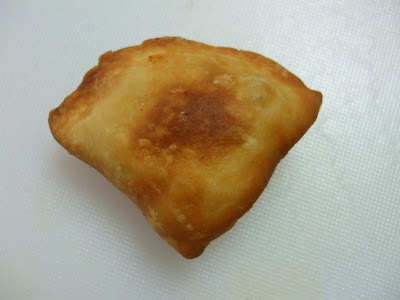Look at that crispy, golden brown goodness. Slightly flaky pastry outside, and fluffy spiced potato filling inside. It's delicious.
I made this samosa to try out my homemade garam masala. I thought that the samosas were going to be just some kind of vehicle for the spices. You know, just a vessel. But, no. Oh, no. It was so much more than that. It's a superstar in its own right.
I wasn't in the mood for meat (weird, right?), so I made some vegetarian samosas instead. The filling was supposed to have potatoes, carrots and peas in it, but I didn't have the latter two ingredients. So, I settled for just potatoes. Don't worry. It's still awesome.
The recipe said that it would make about 24 medium sized samosas. I wouldn't know about that since I made bite-sized ones. So, try it out and see how it works out for you. The dough was wonderful. Most people say that samosas are difficult to make, but I didn't find it that troublesome. The dough was wonderful, and definitely one of the friendliest dough I've ever worked with.
The original recipe for the filling (click here) is wonderful, but I didn't have a couple of the ingredients on there. So, I just adjusted it according to the things in my cupboard.
Vegetarian Samosas
Dough
- 225 gr of flour
- 2 tbs of oil
- 2 tsp of salt
- 80 ml of water
Filling
- 2 large potatoes
- 2 green onions
- about 1/2 inch of ginger, smashed
- 2 green chilies, finely chopped
- 3 tbs of oil
- 1/2 tsp of garlic, minced
- 1/4 to 1/2 tsp of ground coriander
- 1/2 tsp of turmeric (if you have dried sliced turmeric, use 2 to 3 pieces)
- 1/2 tsp of garam masala
- 1/2 tsp of chili powder
- 1/2 to 1 tsp of salt
- For the dough, combine flour and salt in a large bowl. Make a hole in the center of the mixture and pour in the oil and the water. You'll need all of it. Then, use a fork to combine. After a couple of minutes, go in there with your hands. Dump on to a clean surface, and knead into a smooth ball. Cover and let sit at room temperature for 30 minutes.
- Boil the potatoes for about 15 minutes, or until they just become fork tender. Don't make it mushy! After that, use a fork to break up the potatoes into small, crumbly pieces. Don't mash it completely.
- Saute the garlic, green chili, ginger, and coriander in oil for a minute.
- Add the green onions and let it cook for a minute or two. Add turmeric, chili powder, salt, and garam masala. Let it cook for about 2 minutes, and add the cooked potatoes. Only cook until everything is nicely combined.
- After the dough has rested for 30 minutes, divide it into two parts. Then, the divided the two parts into six portions.
- Roll out each portion into a circle as best as you can. Mine were jacked up, too. Don't worry. Cut the circles in half, making two half moon shapes. Take one of them and brush the straight edge with water. Don't overdo the water; it'll make your dough mushy and more prone to tearing when you stuff it.
- After brushing it with water, fold it over and crimp it together to make a cone. Open it up, and insert about 1 tbs of filling. Brush the inner edges of the top of the cone with water and crimp it up nice and tightly.
- Fry the samosas on low to medium heat until they are golden.
The frying part is a little tricky. You kind of have to watch the temperature with these guys. If the oil is too hot, the shell will start to form bubbles that look like tiny blisters. You don't really want that. If the oil isn't hot enough, the thing won't really puff up. So, uh, good luck with that.


















































